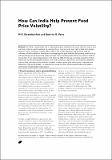| dc.contributor.author | Swaminathan, M.S. | en |
| dc.contributor.author | Vepa, Swarna S. | en |
| dc.date.accessioned | 2016-01-07T13:52:24Z | |
| dc.date.available | 2016-01-07T13:52:24Z | |
| dc.date.issued | 1/7/2012 | en |
| dc.identifier.citation | Swaminathan, M.S. and Vepa, S., S. (2012) How Can India Help Prevent Food Price Volatility?. IDS Bulletin 43: 84-91 | en |
| dc.identifier.issn | 1759-5436 | en |
| dc.identifier.uri | https://opendocs.ids.ac.uk/opendocs/handle/20.500.12413/7543 | |
| dc.description.abstract | This article is about India's role in reducing food price volatility in the world. India has come a long way from a ‘ship?to?mouth existence’ to a country that is ready to confer legal right to food to its citizens based on its own production. India has 18 per cent of the world's population and therefore food self?sufficiency of India would be a blessing for the struggle against price volatility. By improving productivity, by reducing energy use, by augmenting water resources and by conserving prime farm land, India can produce enough food for an estimated population of 1.5 billion by 2030. Further, by controlling speculative trade in food prices, by maintaining stable domestic prices and by sharing its agricultural and food policy expertise, India can help reduce food price volatility. However, to reduce global price volatility and to remove price distortions in the world market, it is important to resolve the issues of agricultural trade and to adopt a small farmer?friendly global trading system. | en |
| dc.format.extent | 8 | en |
| dc.publisher | Blackwell Publishing Ltd | en |
| dc.relation.ispartofseries | IDS Bulletin Vol. 43 Nos. | en |
| dc.rights.uri | http://www.ids.ac.uk/files/dmfile/IDSOpenDocsStandardTermsOfUse.pdf | en |
| dc.title | How Can India Help Prevent Food Price Volatility? | en |
| dc.type | Article | en |
| dc.rights.holder | © 2012 The Authors. IDS Bulletin © 2012 Institute of Development Studies | en |
| dc.identifier.doi | 10.1111/j.1759-5436.2012.00350.x | en |

